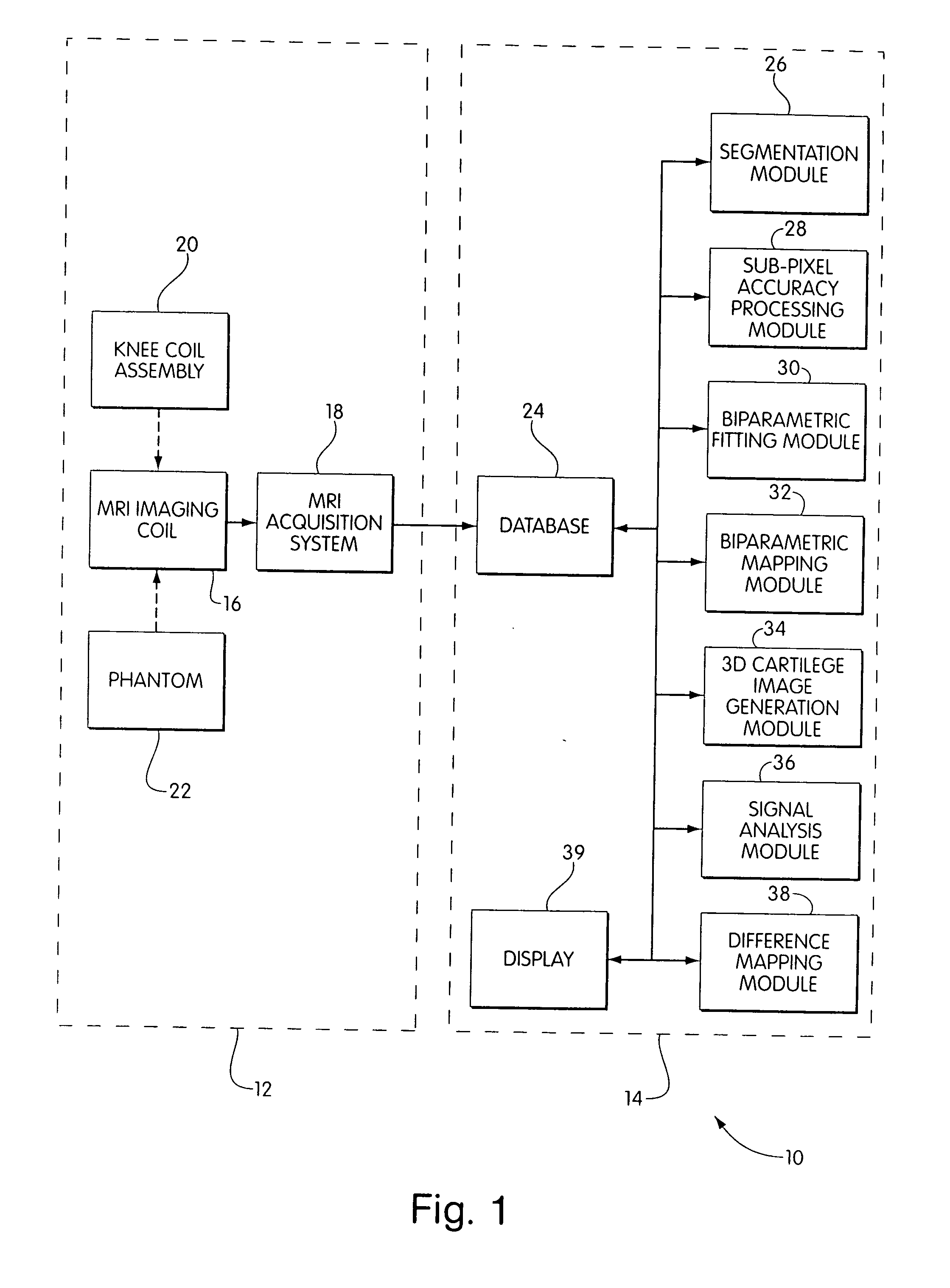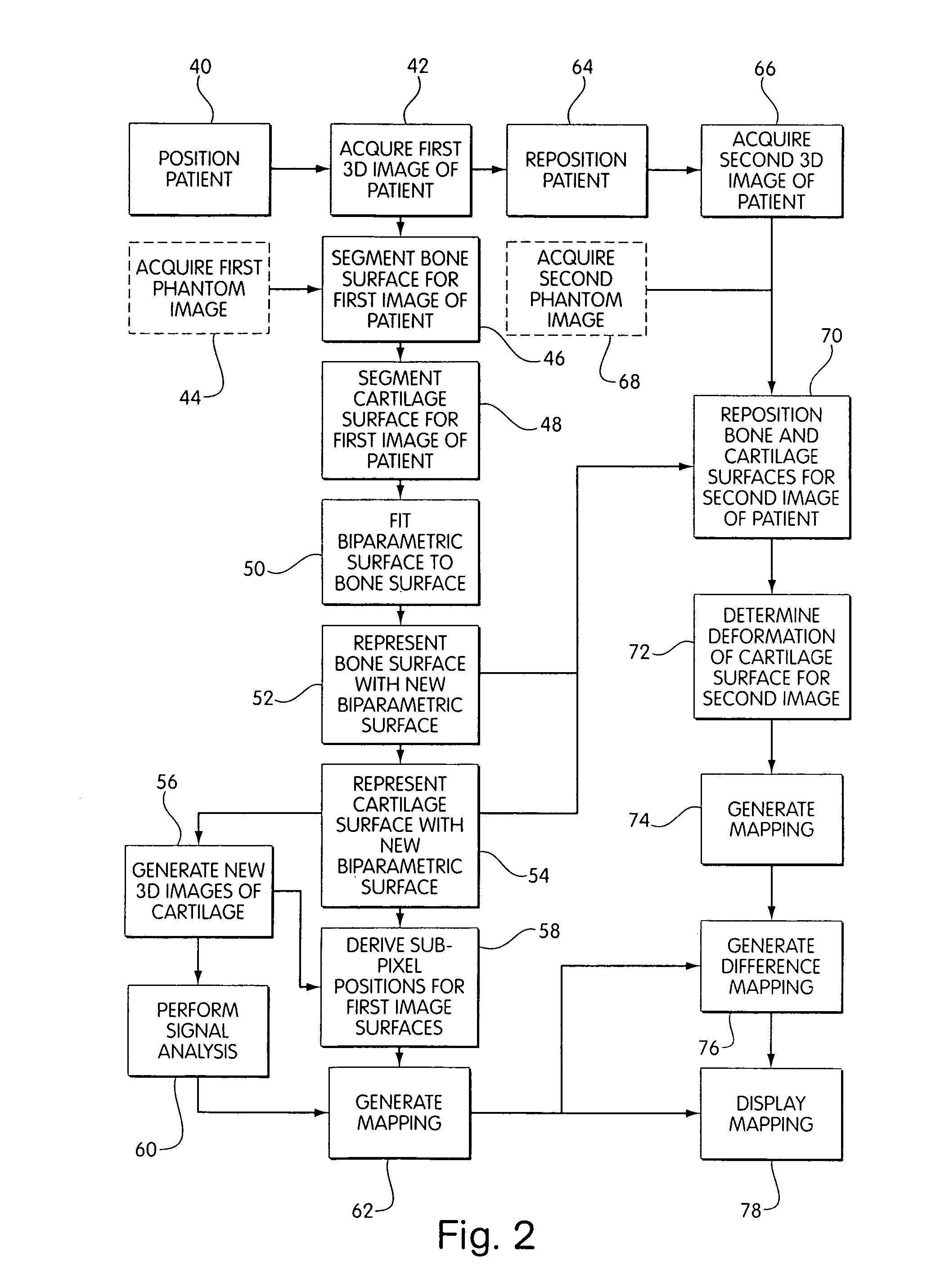Evaluating disease progression using magnetic resonance imaging
a magnetic resonance imaging and disease technology, applied in the field of tracking disease progression using magnetic resonance imaging, can solve the problems of cartilage destruction, severe disability, functional loss of normal matrix physiologic properties, etc., and achieve the effect of accurately determining how and when to treat individual patients, finely targeted treatment research, and effective treatment delivery
- Summary
- Abstract
- Description
- Claims
- Application Information
AI Technical Summary
Benefits of technology
Problems solved by technology
Method used
Image
Examples
example 1
[0095] Fifteen patients with knee osteoarthritis were recruited from outpatient rheumatology clinics. These patients included male and female individuals satisfying American College of Rheumatologists (ACR) criteria for primary osteoarthritis. They were each symptomatic and required treatment.
[0096] In all cases there was radiological evidence of osteoarthritis in the affected knee, including an X-ray within six months. Each patient exhibited a minimal grade two severity on either space narrowing, osteophyte and / or sclerosis on the Kellgren and Lawrence scale. Absence of chondrocalcinosis was required, and patients with end-stage radiological disease (i.e., grade four) or isolated femoropateilar osteoarthritis were not included in the study.
[0097] Patients were ruled out on the basis of a number of possibly confounding conditions, including secondary osteoarthrits, inflammatory arthritis, post-traumatic arthritis, metabolic arthritis, septic arthritis, crystal-induced disease, Pag...
example 2
[0102] Thirty-five patients with knee osteoarthritis were recruited from outpatient rheumatology clinics using similar criteria to those used for the first Example. The patients exhibited the baseline demographics presented in Table 1.
TABLE 1Age (yrs.) 63.1 (9.1)Womac Pain59.4 (3.93)% female 74%Womac Stiff.45.7 (4.77)Weight (kg) 84.1 (15.1)Womac Fnct.60.3 (3.99)% Analg.82.6%Womac Total56.9 (3.99)% NSAIDs 77%Patient Global54.5 (3.74)SF-36 PCS37.1 (1.65)50 Walk (sec) 11.6 (3.6)VAS PAIN48.2 (4.97)ROM (deg.)126.9 (12.2)MD Global59.8 (3.12)
(VAS scores 100 = worst)
[0103] The patients were assessed at baseline, six months, and one year using an MRI system generally comparable to that described above. As part of this assessment, the images obtained were systematically analyzed and quantified using a processing system generally comparable to that described above. Imaging parameters were: Voxel size: 0.3×0.4×1 mm, with a 512×410 grid; 3D FISP; TR=42, and TE=7.
[0104] The total cartilage ...
PUM
 Login to View More
Login to View More Abstract
Description
Claims
Application Information
 Login to View More
Login to View More - R&D
- Intellectual Property
- Life Sciences
- Materials
- Tech Scout
- Unparalleled Data Quality
- Higher Quality Content
- 60% Fewer Hallucinations
Browse by: Latest US Patents, China's latest patents, Technical Efficacy Thesaurus, Application Domain, Technology Topic, Popular Technical Reports.
© 2025 PatSnap. All rights reserved.Legal|Privacy policy|Modern Slavery Act Transparency Statement|Sitemap|About US| Contact US: help@patsnap.com



